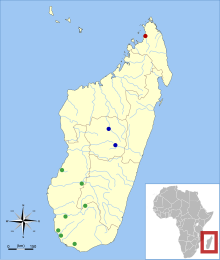
Back سيفاكا وسيط Arabic Mesopropitec Catalan Mesopropithecus German Μεσοπροπίθηκος Greek Mesopropithecus Spanish Mesopropithecus French Mesopropithecus Italian Mesopropithecus Dutch Мезопропитеки Russian Mesopropithecus Swedish
| Mesopropithecus Temporal range: Quaternary
| |
|---|---|

| |
| Mesopropithecus globiceps skull | |
| Scientific classification | |
| Domain: | Eukaryota |
| Kingdom: | Animalia |
| Phylum: | Chordata |
| Class: | Mammalia |
| Order: | Primates |
| Suborder: | Strepsirrhini |
| Family: | †Palaeopropithecidae |
| Genus: | †Mesopropithecus Standing, 1905[1] |
| Species[2] | |
| |

| |
| Subfossil sites for Mesopropithecus[2]red = M. dolichobrachion;green = M. globiceps;blue = M. pithecoides | |
| Synonyms[1][4] | |
|
Neopropithecus Lamberton, 1936 | |
Mesopropithecus is an extinct genus of small to medium-sized lemur, or strepsirrhine primate, from Madagascar that includes three species, M. dolichobrachion, M. globiceps, and M. pithecoides. Together with Palaeopropithecus, Archaeoindris, and Babakotia, it is part of the sloth lemur family (Palaeopropithecidae). Once thought to be an indriid because its skull is similar to that of living sifakas, a recently discovered postcranial skeleton shows Mesopropithecus had longer forelimbs than hindlimbs—a distinctive trait shared by sloth lemurs but not by indriids. However, as it had the shortest forelimbs of all sloth lemurs, it is thought that Mesopropithecus was more quadrupedal and did not use suspension as much as the other sloth lemurs.
All three species ate leaves, fruits, and seeds, but the proportions were different. M. pithecoides was primarily a leaf-eater (folivores), but also ate fruit and occasionally seeds. M. globiceps ate a mix of fruits and leaves, as well as a larger quantity of seeds than M. pithecoides. M. dolichobrachion also consumed a mixed diet of fruits and leaves, but analysis of its teeth suggests that it was more of a seed predator than the other two species.
Although rare, the three species were widely distributed across the island yet allopatric to each other, with M. dolichobrachion in the north, M. pithecoides in the south and west, and M. globiceps in the center of the island. M. dolichobrachion was the most distinct of the three species due to its longer arms. Mesopropithecus was one of the smallest of the known extinct subfossil lemurs, but was still slightly larger than the largest living lemurs. Known only from subfossil remains, it died out after the arrival of humans on the island, probably due to hunting pressure and habitat destruction.
- ^ a b Cite error: The named reference
1999Nowak_p89-91was invoked but never defined (see the help page). - ^ a b Cite error: The named reference
2002Godfreywas invoked but never defined (see the help page). - ^ Cite error: The named reference
2010Godfreywas invoked but never defined (see the help page). - ^ Cite error: The named reference
1997McKennawas invoked but never defined (see the help page).